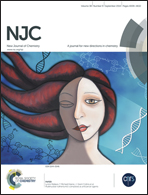Synthesis of copper–isonicotinate metal–organic frameworks simply by mixing solid reactants and investigation of their adsorptive properties for the removal of the fluorescein dye†
Abstract
The formation of [Cu(INA)2] (INA = isonicotinate) metal–organic frameworks (MOFs) by a highly efficient and environmentally benign method simply by mixing and heating solid reactants without milling has been investigated. The materials were characterized using elemental analysis, FT-IR spectroscopy and powder X-ray diffraction (PXRD) and scanning electron microscopy (SEM). Comparison of PXRD patterns of the materials with patterns simulated from single crystal X-ray diffraction data allowed identification of the products. The adsorption properties of [Cu(INA)2] were studied using the fluorescein dye (FS). The adsorption data followed both Langmuir and Freundlich equations but was best suited to the Langmuir model. The adsorption data were also correlated with the Temkin and Dubinin–Radushkevich adsorption model and the results showed that the adsorption process is physical. These results indicate that the adsorption of FS on [Cu(INA)2] is partly due to electrostatic interaction between fluorescein and the adsorbent. Compared with the traditional synthetic techniques, this method for the synthesis of MOFs was found to be highly efficient, environmentally benign and useful for the large-scale production.


 Please wait while we load your content...
Please wait while we load your content...